
A reusable bottle is a bottle that can be reused, as in the case as by the original bottler or by end-use consumers. Reusable bottles have grown in popularity by consumers for both environmental and health safety reasons. Reusable bottles are one example of reusable packaging.

The Poodle, called the Pudel in German and the Caniche in French, is a breed of water dog. The breed is divided into four varieties based on size, the Standard Poodle, Medium Poodle, Miniature Poodle and Toy Poodle, although the Medium Poodle is not universally recognised. They have a distinctive thick, curly coat that comes in many colors and patterns, with only solid colors recognized by breed registries. Poodles are active and intelligent, and are particularly able to learn from humans. Poodles tend to live 10–18 years, with smaller varieties tending to live longer than larger ones.
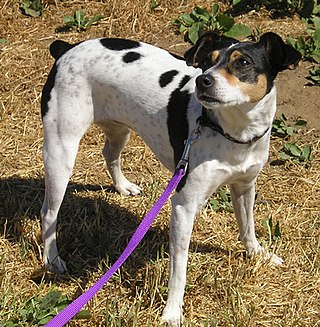
A leash is a rope or similar material used to control an animal by attaching it to a collar, harness, or halter. In British English, a leash is generally for a larger animal, with lead being more commonly used when walking a dog.
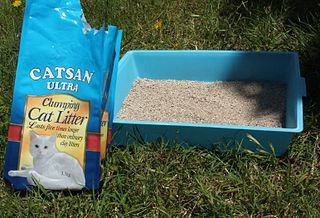
A litter box, also known as a sandbox, cat box, litter tray, cat pan, potty, pot or litter pan, is an indoor feces and urine collection box for cats, as well as rabbits, ferrets, miniature pigs, small dogs, and other pets that instinctively or through training will make use of such a repository. They are provided for pets that are permitted free roam of a home but who cannot or do not always go outside to excrete their metabolic waste.

Housebreaking or house-training is the process of training a domesticated animal that lives with its human owners in a house or other residence to excrete outdoors, or in a designated indoor area, rather than to follow its instinctive behaviour randomly inside the house.

The Havanese, a bichon-type dog, is the national dog of Cuba, developed from the now extinct Blanquito de la Habana. The Blanquito descended from the also now-extinct Bichón Tenerife. It is believed that the Blanquito was eventually cross-bred with other bichon types, including the poodle, to create what is now known as the Havanese. Sometimes referred to as "Havana Silk Dogs", but this is a separate breed, which has been bred to meet the original Cuban standards.
The Pet Travel Scheme ("PETS") is a system which allows animals to travel easily between member countries without undergoing quarantine. A pet passport is a document that officially records information related to a specific animal, as part of that procedure. The effect is to drastically speed up and simplify travel with and transport of animals between member countries, compared to previous procedures if the regulations are followed.

Crate training is the process of training a pet to tolerate confinement in a dog crate or cage. Crate advocates often claim that dogs are "den-dwelling" animals and that a crate can become a "den" substitute and a familiar and safe location for the pet. Most puppies can eventually tolerate crate training if it is introduced properly. The initial stress from being confined can give way to "increased feelings of security, safety, and comfort" after repeated exposure to the crate. Long-term or excessive crate confinement "may lead to emotional and behavioral deterioration over time." On the other hand, if properly done, crate training can play a major role in housebreaking a dog as fast as possible. Confining a dog in a crate or cage restricts its movement and freedom, If crate training is not taken seriously, the dog may start soiling around the house.

Greyhound adoption or Greyhound rescue programs focus on finding homes for Greyhounds who are no longer needed for racing. In some countries, they live in kennels at the track.

A pet harness is equipment consisting of straps of webbing that loop nearly around—that fasten together using side release buckles—the torso of an animal.
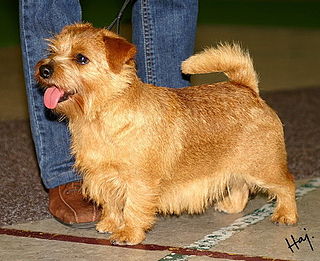
The Norfolk Terrier is a British breed of dog. Prior to gaining recognition as an independent breed in 1964, it was a variety of the Norwich Terrier, distinguished from the "prick eared" Norwich by its "drop ears". Together, the Norfolk and Norwich Terriers are the smallest of the working terriers.

A tonneau, bed or tray is an area of a car or truck open at the top. It can be for passengers or cargo.

A muzzle is a device that is placed over the snout of an animal to keep them from biting or otherwise opening their mouth.
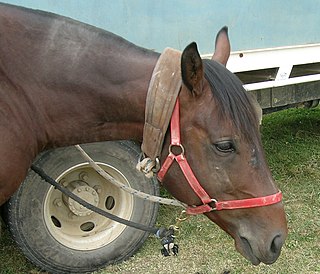
An animal collar is a device that attaches to the neck of an animal to allow it to be harnessed or restrained.

A pet door or pet flap is a small opening to allow pets to enter and exit a building on their own without needing a human to open the door. Originally simple holes, the modern form is a hinged and often spring-loaded panel or flexible flap, and some are electronically controlled. They offer a degree of protection against wind, rain, and larger-bodied intruders entering the dwelling. Similar hatches can let dogs through fences at stiles. A related concept is the pet gate, which is easy for humans to open but acts as a secure pet barrier.
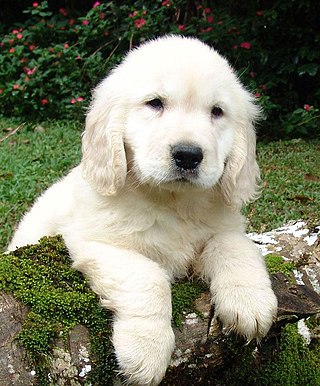
A puppy is a juvenile dog. Some puppies can weigh 1–1.5 kg (2.2–3.3 lb), while larger ones can weigh up to 7–11 kg (15–24 lb). All puppies display primary altriciality and healthy puppies grow quickly after birth. A puppy's coat color may change as the puppy grows older, as is commonly seen in breeds such as the Yorkshire Terrier. Puppy refers specifically to young dogs, while pup may be used for other animals such as wolves, seals, giraffes, guinea pigs, rats or sharks.

The German Longhaired Pointer (GLP) is a breed of dog. Developed in Germany, it is used as a multipurpose gundog. It is closely related to its cousins, the German Shorthaired Pointer (GSP), the German Wirehaired Pointer (GWP) and the Large Münsterländer, which was previously part of the breed.
Pet shipping is an industry that involves transporting animals, specifically pets, often by plane. This service is commonly used when the animal's owner is moving house. However, it can also be used when transporting animals for other reasons, such as performing in dog shows. The worldwide industry body for pet shipping is the International Pet and Animal Transportation Association. Pet microchips, vaccinations, rabies titre tests, import permits, and health certificates may be required to ship an animal. Certain breeds are banned from the process due to the increase in associated risk.
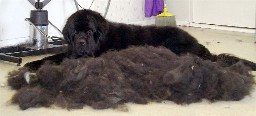
Dog grooming refers to both the hygienic care and cleaning of a dog, as well as a process by which a dog's physical appearance is enhanced for showing or other types of competition. A dog groomer is a person who earns their living grooming dogs.

Pet carriers are small portable boxes, crates, or cages used to transport small animals such as cats, lap dogs, miniature pigs, ferrets, chickens, guinea pigs, and so on, from one location to another.



















